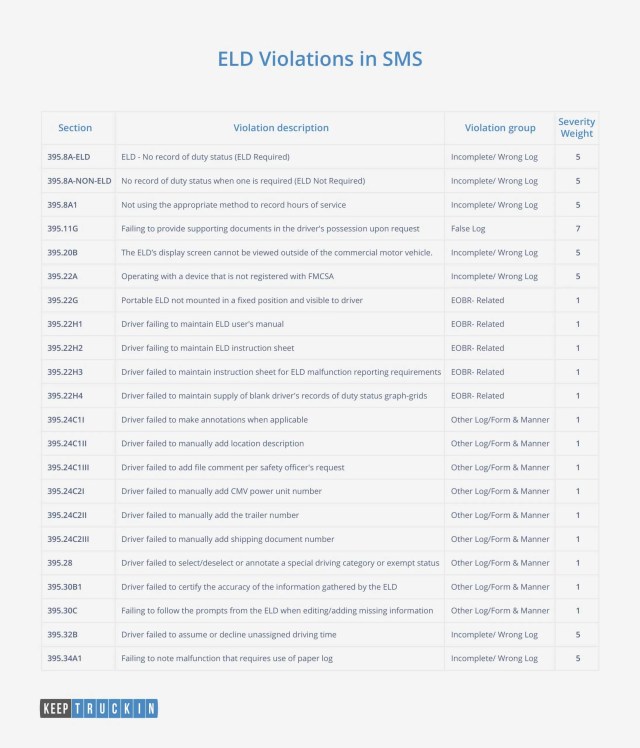The FMCSA recently updated the CSA’s Safety Measurement System (SMS) with new ELD violations and severity weights. There are now 22 ELD-related violations that count against SMS scores.
ELD violations didn’t affect CSA scores during the “soft enforcement” period between December 18, 2017, and April 1, 2018.
Now that full enforcement of the FMCSA’s ELD mandate has begun, ELD violations do affect CSA scores. If a non-exempt driver doesn’t have an ELD when required, they’ll be placed out-of-service for at least 10 hours.
That’s not a situation you want to be in.
In this blog post, we take an in-depth look at the true “cost” of ELD violations, their impact on CSA scores, and how you can avoid ELD violations.
ELD violations and CSA scores
As we mentioned earlier, ELD violations now affect a carrier’s CSA scores.
Although any violation recorded before April 1, 2018, won’t appear in the CSA SMS, violations recorded after April 1 will be counted against SMS scores. These violations can be seen in the May 2018 monthly SMS results.
Different violations carry different severity weights. Following is a list of 22 ELD-related violations, along with the severity weight of each.

395.11G — “a failure to provide supporting documents in the driver’s possession upon request” carries the most violation points, 7 out of 10.
A few smaller violations have a severity weight of 1 out of 10, such as failing to make annotations, failing to manually add location description, and failing to maintain an ELD instruction sheet. Although these violations are smaller in terms of severity weights, they shouldn’t be neglected.
With proper driver training and awareness, these violations can be easily avoided. For more information, read how to avoid ELD violations.
Drivers are being placed out-of-service
As we discussed earlier, if a non-exempt driver doesn’t have an ELD when required, the driver is placed out-of-service for at least 10 hours. Drivers can also be placed out-of-service for using an unauthorized ELD or AOBRD and falsifying logs.
Assuming that the driver at least has paper logs, the driver may be allowed to reach the final destination and deliver the load after the 10-hour out-of-service period is up. However, they can’t be dispatched on their next trip until they comply with the ELD mandate. That requires installing an FMCSA-registered electronic logging device.
If a driver is dispatched again without an authorized ELD, the driver and carrier may face more enforcement actions.
The cost of violations and OOS
Every day brings an estimated loss of $264 in revenue when a driver is out-of-service. When a driver gets an out-of-service order, the vehicle will likely have to be towed. The cost of towing varies, but a 40-mile tow could cost up to $344.
Fines for ELD violations could range from $1,000 to $10,000. According to the North American Transportation Association, a failure to comply with 395.8(A) has an average fine of $2,867. The highest recorded fine is $13,680.
Violations hurt your CSA scores. And high CSA scores increase your chances for a roadside inspection. High CSA scores also hampers your ability to get the best-paying loads and explore lucrative business opportunities.
ELD violations can cost you thousands of dollars. In comparison, the Motive ELD only costs a few dollars per month.
The Motive ELD is a highly rated ELD solution on the market. Over 60,000 carriers and 1 million registered drivers use and trust Motive for their compliance, regulatory, and fleet management needs.
With the right kind of ELD solution — one that is reliable and guarantees compliance — you can avoid ELD violations and improve your CSA scores. Motive is the perfect ELD solution for that.
Request a free demo today and try the Motive ELD and fleet management solution.



